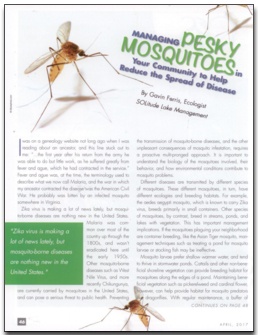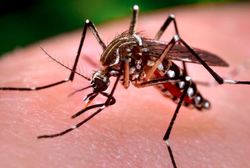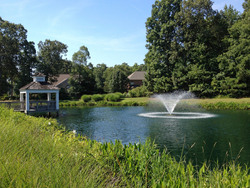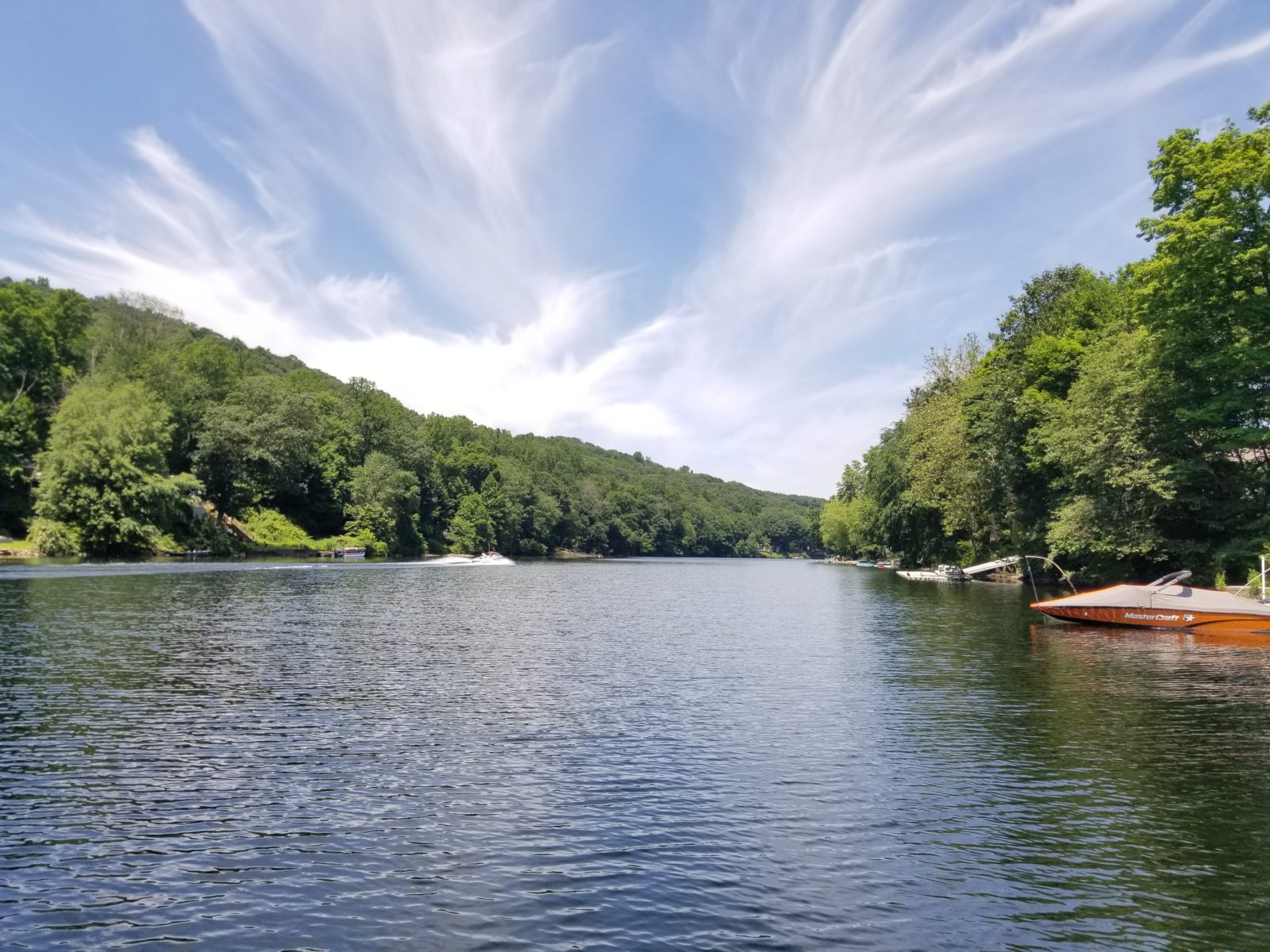Managing Mosquitoes: Help Reduce the Spread of Disease
June 19th, 2017
AS SEEN IN Various Community Associations Institute Chapter Newsletters: Written by Industry Expert Gavin Ferris, Ecologist
 I was on a genealogy website not long ago when I was reading about an ancestor, and this line stuck out to me: “…the first year after his return from the army he was able to do but little work, as he suffered greatly from fever and ague, which he had contracted in the service.” Fever and ague was, at the time, the terminology used to describe what we now call Malaria, and the war in which my ancestor contracted the disease was the American Civil War. He probably was bitten by an infected mosquito somewhere in Virginia.
I was on a genealogy website not long ago when I was reading about an ancestor, and this line stuck out to me: “…the first year after his return from the army he was able to do but little work, as he suffered greatly from fever and ague, which he had contracted in the service.” Fever and ague was, at the time, the terminology used to describe what we now call Malaria, and the war in which my ancestor contracted the disease was the American Civil War. He probably was bitten by an infected mosquito somewhere in Virginia.
Zika virus is making a lot of news lately, but mosquito-borne diseases are nothing new in the United States. Malaria was common over most of the country up through the 1800s, and wasn’t eradicated here until the early 1950s. Other mosquito-borne diseases such as West Nile Virus, and more recently Chikungunya, are currently carried by mosquitoes in the United States, and can pose a serious threat to public health. Preventing the transmission of mosquito-borne diseases, and the other unpleasant consequences of mosquito infestation, requires a proactive multi-pronged approach. It is important to understand the biology of the mosquitoes involved, their behavior, and how environmental conditions contribute to mosquito problems.
Different diseases are transmitted by different species of mosquito. These different mosquitoes, in turn, have different ecologies and breeding habitats. For example, the Aedes aegypti mosquito, which is known to carry Zika virus, breeds primarily in small containers. Other species of mosquitoes, by contrast, breed in streams, ponds, and lakes with vegetation. This has important management implications. If the mosquitoes plaguing your neighborhood are container breeding, like the Asian Tiger mosquito, management techniques such as treating a pond for mosquito larvae or fish stocking may be ineffective.
 Mosquito larvae prefer shallow warmer water, and tend to thrive in stormwater ponds. Cattails and other non-beneficial shoreline vegetation can provide breeding habitat for mosquitoes along the edges of a pond. Maintaining a beneficial vegetative buffer of plants such as Pickerelweed and Cardinal Flower, however, can help provide habitat for mosquito predators like dragonflies. With regular maintenance, a buffer of native plants can also be managed to help control erosion without creating breeding pools for mosquitoes. Keeping a pond adequately stocked with an appropriate species of small fish like Fathead minnows or bluegill is the most effective means of controlling any mosquitoes that may be breeding in shallow areas. Circulating the water with a fountain or submersed aeration system also makes the waterbody less hospitable to algae, as does treating the weeds and algae that can create isolated pockets where mosquitoes may be able to reproduce.
Mosquito larvae prefer shallow warmer water, and tend to thrive in stormwater ponds. Cattails and other non-beneficial shoreline vegetation can provide breeding habitat for mosquitoes along the edges of a pond. Maintaining a beneficial vegetative buffer of plants such as Pickerelweed and Cardinal Flower, however, can help provide habitat for mosquito predators like dragonflies. With regular maintenance, a buffer of native plants can also be managed to help control erosion without creating breeding pools for mosquitoes. Keeping a pond adequately stocked with an appropriate species of small fish like Fathead minnows or bluegill is the most effective means of controlling any mosquitoes that may be breeding in shallow areas. Circulating the water with a fountain or submersed aeration system also makes the waterbody less hospitable to algae, as does treating the weeds and algae that can create isolated pockets where mosquitoes may be able to reproduce.
With regard to Zika virus, the offending mosquitoes utilize containers for breeding. They are found primarily in a swath of the Southeastern US from South Carolina across to the gulf coast of Texas, but are a growing concern for areas throughout the United States. The best way to prevent their prevalence locally is to limit their breeding habitat. When possible, standing water should be eliminated by clearing up litter, keeping gutters clean, repairing potholes, emptying containers and removing tire piles. Small pools that cannot be reliably kept dry like flower pots, bird baths, and very small stormwater basins can be treated with a bacteria called Bacillus thurengiensis israelensis, commonly abbreviated as Bti. This bacteria produces a toxin that is only harmful to some insects, including mosquitoes.

For communities, an Integrated Mosquito Management program can further help to prevent disease and keep pesky mosquitoes at bay. Typically, such a program begins with public education. Depending on the species of mosquito in question, they may only be active during certain times of day. Informing the public about ways to avoid exposure to mosquitos and reduce breeding habitat on their property, and promoting the use of repellents can help to mitigate against the risks posed by mosquitos even before control efforts are implemented.
An integrated approach to mosquito management also includes surveillance and testing efforts. This typically includes the sampling of breeding habitats for the presence of mosquito larvae, and the use of various types of mosquito traps to determine which species are present and at what densities. Mosquito species capable of transmitting certain diseases can be tested, and areas where the disease is detected can then be made the priority for intensive treatment.
Even if you live an area with low risk of Zika or West Nile virus, mosquitoes are a royal pain that nobody wants to deal with. While mosquitoes are an annoyance and a hazard that we are unlikely to remove entirely from our lives, they can be mitigated against by limiting and managing their breeding habitats. Implementing a proactive and integrated management approach that addresses all aspects of the problem is essential to helping prevent mosquito bites and the transmission of serious disease.
Contact the experts at 888-480-5253 for all of your lake, pond and fisheries management needs.
 Gavin Ferris is an Ecologist with SOLitude Lake Management. As an entomologist and ecologist, Gavin has a keen understanding of the organisms and processes that allow a healthy ecosystem to function. By incorporating concepts of ecological sustainability and community ecology into his treatment and maintenance strategies, he is able to improve not only a pond’s appearance, but also its health and resilience to pollution and invasive species.SOLitude Lake Management is committed to providing full service lake and pond management services that improve water quality, preserve natural resources, and reduce our environmental footprint. Our services include lake, pond and fisheries management programs, algae and aquatic weed control, mechanical harvesting, hydro-raking, installation and maintenance of fountains and aeration systems, water quality testing and restoration, bathymetry, lake vegetation studies, biological assessments, habitat assessments, invasive species management and nuisance wildlife management. Services, consulting and aquatic products are available to clients nationwide, including homeowners associations, multi-family and apartment communities, golf courses, commercial developments, ranches, private landowners, reservoirs, recreational and public lakes, municipalities, parks, and state and federal agencies. Learn more about SOLitude Lake Management and purchase products at www.solitudelakemanagement.com.
Gavin Ferris is an Ecologist with SOLitude Lake Management. As an entomologist and ecologist, Gavin has a keen understanding of the organisms and processes that allow a healthy ecosystem to function. By incorporating concepts of ecological sustainability and community ecology into his treatment and maintenance strategies, he is able to improve not only a pond’s appearance, but also its health and resilience to pollution and invasive species.SOLitude Lake Management is committed to providing full service lake and pond management services that improve water quality, preserve natural resources, and reduce our environmental footprint. Our services include lake, pond and fisheries management programs, algae and aquatic weed control, mechanical harvesting, hydro-raking, installation and maintenance of fountains and aeration systems, water quality testing and restoration, bathymetry, lake vegetation studies, biological assessments, habitat assessments, invasive species management and nuisance wildlife management. Services, consulting and aquatic products are available to clients nationwide, including homeowners associations, multi-family and apartment communities, golf courses, commercial developments, ranches, private landowners, reservoirs, recreational and public lakes, municipalities, parks, and state and federal agencies. Learn more about SOLitude Lake Management and purchase products at www.solitudelakemanagement.com.










